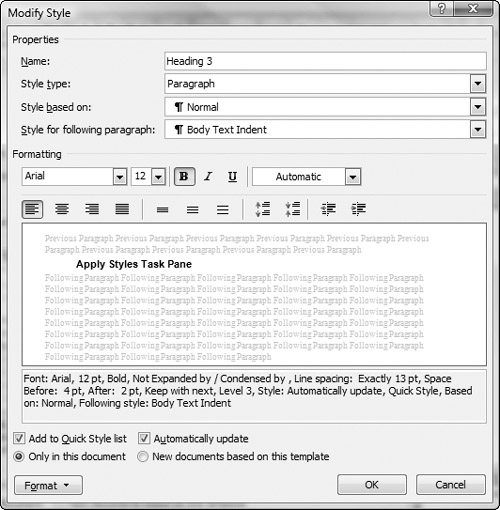Styles Group
The most visible Ribbon control for applying and changing styles is the Styles group in the Home tab of the Ribbon. Seemingly simple, the Styles group is the tip of a rather large iceberg.
On its face are four controls, shown in Figure 7-1: the Quick Styles Gallery, Change Styles (for selecting Style sets), More, and the Styles Dialog Box Launcher.
Figure 7-1. The Styles group is the command and control center for styles.
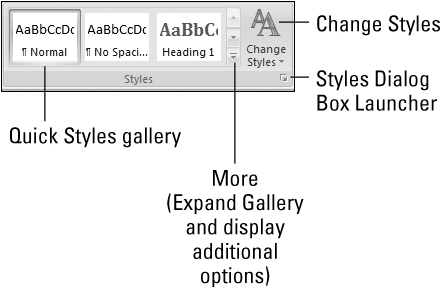
Note
The word “quick” very likely will confuse many users. You might also notice that the term “Quick Style” also applies to the gallery used for SmartArt. These are not related. One way to deal with the disconnect is to think of them as different kinds of styles—one you apply to text elements, the other you apply to certain kinds of graphic elements. We will look at SmartArt “styles” in Chapter 9.
In a normal screen configuration and resolution, the Quick Styles gallery shows only three to five styles. In a very high resolution setup with a sufficiently wide monitor, it can show up to a dozen styles without having to use the More control. Clicking the More button shows more of the styles in the Quick Styles gallery, as shown in Figure 7-2. If there are still more styles in the gallery, they can be accessed using the vertical scroll bar or by dragging the right corner control to expand or shrink the size of the gallery.
The Styles group also provides access to Quick Style sets. If you click Change Styles and then click Style Set, you see additional new toys, shown in Figure 7-3. The options shown—Default (Black and White), Distinctive, and so on, are carefully constructed sets of styles that are coordinated to help you quickly change the look of your document. (You’ll see where those Quick Style sets come from later in this chapter.)
Figure 7-3. Quick Style sets offer additional coordinated styles to help achieve a different “look” for your documents.

Notice also the Colors and Fonts controls. These tools work with themes, which aren’t the same thing as styles. Like Quick Style sets, themes can be used to dramatically change the appearance of your document. Unlike Quick Style sets, however, they are tied to the use of theme elements in your document.
Note
Theme is a feature new to Word 2007, and does not work with compatibility mode documents. In the Change Styles list, Style Set is available, but Colors and Fonts are not. These features are available, however, not only when working with Word 2007 documents, but also when working with web-oriented documents (*.mht, *.htm, *.html, etc.). Themes are explored in Chapter 8, “Page Setup and Sections.”
The effect of different style sets—indeed, seeing any effect at all—depends on your having used styles in your document. If you simply use the style Normal, then at most applying a new Quick Style set will change the font. For maximum benefit from Word’s new style features, you need to lay the proper foundation, which means using styles to differentiate different kinds of text (headings, body, captions, etc.).
Using styles
When you first start typing in any Word document, you’re automatically using the default style. Ordinarily, that would be Normal.
Note
The style named Normal is wholly independent of the fact that there is a Word template named Normal.dotm. Normal.dotm contains many different styles, and one of them happens to be named Normal. In fact, every Word template contains a style named Normal. This is nothing more than an unfortunate, confusing, and creativity-challenged choice of names. They could have named Word’s default style Base or Body, and I really wish they had. It would make notes like this one unnecessary. Fortunately, Normal view has been renamed Draft view, so at least we no longer have to deal with that added bit of creativity-challenged confusion.
As you type different parts of any document, you should consider applying an appropriate style. For example, if you type a heading, consider applying a heading style to it, such as Heading 1, 2, or 3. To do this, click the heading style in the Quick Styles gallery, as shown in Figure 7-4. If Heading 1 isn’t showing, then click the More button to the right of the Styles, also shown in Figure 7-4.
Figure 7-4. Click a style in the Quick Styles gallery to apply it to the current paragraph or selection.

Apply styles task pane
If you’re accustomed to Word 2003 or earlier, you can also apply a style in a way that’s similar. In Word 2003, you could either click in the Style drop-down tool or press Ctrl+Shift+S. There is no default Style drop-down in Word 2007, but Ctrl+Shift+S activates the Apply Styles task pane, shown in Figure 7-5. Once the Apply Styles task pane is visible, it can be used in a way that’s similar but not identical to Word 2003’s Style tool.
Figure 7-5. Press Ctrl+Shift+S to activate the Apply Styles task pane, which is Word 2007’s substitute for Word’s earlier Style tool in the Formatting toolbar.
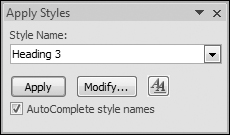
Tip
In the preceding paragraph, I said there is no default Style drop-down tool. There isn’t. However, there is one you can add to the Quick Access Toolbar. Unfortunately, you can’t assign a keystroke to it, but you can at least use it for setting the style using the mouse. More important, it displays the style assigned to the insertion point all the time, unlike the Quick Styles gallery.
To put this tool onto your QAT, right-click the QAT and choose Customize Quick Access Toolbar. Set Customize Quick Access Toolbar to For All Documents (default). Choose Commands Not in the Ribbon from the Choose Commands From drop-down list. Click in the list of commands and tap the T key. This displays the first command starting with T, but also exposes all of the commands beginning with “Style.” Click on the command named just Style. When you hover the mouse over it, the tooltip says “Style (StyleGalleryClassic).” With Style selected, click Add to add it to the QAT. Click OK, and you’re done.
Creating and modifying styles
Often, when you use a built-in heading style, it does not suit your needs. The font or point size might be wrong, or, the spacing might be off. No problem. Change it. Or, if you still need the existing style but want a slightly different version for another purpose, create a new style.
To change an existing style, right-click the style in the Quick Styles gallery and choose Modify. This displays the Modify Style dialog box shown in Figure 7-6. Make the desired change to the style. If the formatting you need to change isn’t shown, click Format in the southwest corner and choose from the seven different categories of formatting.
Caution
Keep Automatically Update turned off unless you absolutely need it (for example, if your company’s policy requires it be used). The Automatically Update setting can bring much joy or much sorrow. If enabled, when you make changes to Heading 3, for example, those changes are automatically incorporated in the style’s definition. All other text in the document formatted using that style will automatically change to reflect the changes in the style’s definition. If you’re using styles correctly, this can bring great joy.
If, on the other hand, you’ve misused Body Text throughout the document, applying direct formatting in various locations to make it “look right,” then you could be in for an unpleasant shock. Suppose a modified Body Text style sometimes is used on a heading, other times used for a caption, and other times for other purposes. Each time you modify the Body Text style in one place, all other instances in your document also change, undoing your careful direct formatting. This can happen without you realizing it, because the updated instances may be miles away in another part of the document. By the time you see what’s happening, it might be too late for a Ctrl+Z miracle. On the bright side, the Automatically Update option does not exist for the Normal style. This option was the cause of much grief in Word 2003 and earlier. Its removal from the Normal style in Word 2007 will prevent a great many self-inflicted mishaps!
While there is a special New Style dialog box you can use (available from the bottom of the Styles task pane and the Manage Styles dialog box, for example), you aren’t limited to that method. In Figure 7-6, where it says Heading 3, you can type a new style name. When you click OK, the style is created!
Style by example
Another way to modify a style assumes that Automatically Update is not enabled, and that Prompt to Update Style is enabled in the Advanced section of the Word Options dialog box. Choose Office Button ![]() Word Options
Word Options ![]() Advanced, and in the Editing Options section, click to enable Prompt to Update Style. Assuming that Automatically Update is not enabled for a given style, you can now perform what’s sometimes called style-by-example. We also need to assume that you’re not using the Normal style, as it plays by different rules (Automatically Update doesn’t work for Normal).
Advanced, and in the Editing Options section, click to enable Prompt to Update Style. Assuming that Automatically Update is not enabled for a given style, you can now perform what’s sometimes called style-by-example. We also need to assume that you’re not using the Normal style, as it plays by different rules (Automatically Update doesn’t work for Normal).
Use whatever formatting controls you like—Ribbon, keyboard shortcuts, dialog boxes, and so on—to tweak text so that it looks the way you want. When you’ve got it looking just so, you can either create a new style or modify the current one. Note that you should modify a given style only if you want all other text formatted with that style to be formatted the same way.
To create a new style, type the new style name in the Style Name box in the Apply Styles task pane, and then press Enter to apply it.
To modify the existing style, click Reapply on the Apply Styles task pane. Or, reapply the current style using some other method such as the Quick Style Gallery or a keyboard shortcut. Word now prompts you with the dialog box shown in Figure 7-7. Note that you will never see this dialog box if the current style is Normal. Normal marches to a different drummer and is designed to resist easy changes that might have major unintended consequences.
Figure 7-7. When enabled, the Advanced Word option Prompt to Update Style tells Word to prompt you when you attempt to reapply a style (other than Normal) to text that contains formatting that differs from the current style’s settings.

Choose the Update the Style to Reflect Current Changes option to redefine the current style according to the formatting in the current selection (that’s what “recent changes” really means—it doesn’t mean “in the last week or two”). The Reapply the Formatting of the Style to the Selection option will undo your direct formatting and reapply the original style. Note that Automatically Update the Style From Now On enables (checks) the Automatically Update checkbox in the Modify Style dialog box. Think long and hard before you ever check that checkbox!
Caution
Furthermore, redefining a style works on the Normal style! This can be good or bad. Consider, for example, that many styles are based on Normal. If you change the font, for example, every style that gets its font definition from Normal changes too. If you change the Before or After spacing, the indentations, the alignment, and so on, then every style that inherits those attributes from Normal will also change. Only rarely will that be exactly what you want.
Quick Style sets
Quick Style sets are a potentially confusing new addition to Word’s formatting arsenal. Quick Style sets get their information from a set of .dotx (not macro-enabled) templates. In the Styles group of the Home tab on the Ribbon, choose Change Styles ![]() Style Set and look at the names: Default (Black and White), Distinctive, Elegant, and so on.
Style Set and look at the names: Default (Black and White), Distinctive, Elegant, and so on.
These sets correspond to .dotx files stored in C:Program FilesMicrosoft OfficeOFFICE121033QuickStyles, as shown in Figure 7-8.
Figure 7-8. The Quick Style sets are stored as .dotx files, and can be changed or customized by the user.
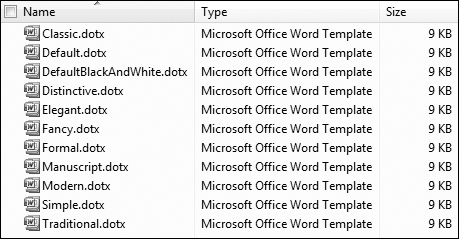
Note
These .dotx files contain no text or other formatting, but only style information for 135 built-in styles (no, this is not the entire list; a few notable missing styles are footnote, endnote, header, and footer).
When you apply a new Quick Style set by choosing Change Styles ![]() Style Set and clicking on one of the displayed sets, Word replaces the style definitions in the current document with those contained in the corresponding .dotx file. It effectively overlays a new document template on top of what you’re already using (even though the name of the underlying document template does not change). All style-formatted text that uses any of the styles in the replaced Quick Style set is affected.
Style Set and clicking on one of the displayed sets, Word replaces the style definitions in the current document with those contained in the corresponding .dotx file. It effectively overlays a new document template on top of what you’re already using (even though the name of the underlying document template does not change). All style-formatted text that uses any of the styles in the replaced Quick Style set is affected.
I emphasize style-formatted because if paragraphs have direct formatting applied, then that formatting will not be overridden. The attributes of the selected text that are applied only through a style are changed. For example, if you manually change the alignment of a series of paragraphs from centered to left aligned, then any alignment formatting in a Quick Style set you apply will be ignored.
Modifying and creating quick style sets
Quick Style sets are not carved into stone. You can modify the ones that Microsoft provides, and you can create your own.
You should modify the ones that Microsoft provides, by the way, only when a built-in Quick Style set’s original form is something you wouldn’t be caught dead using. While you can recover the original, it’s easier to simply use a different name, such as Classic Bert, so you recognize it as your own variation (assuming your name is Bert).
To easily modify a set that Microsoft provides, open a document that is affected by a Quick Style set, and apply the style set you want to use, using Change Styles ![]() Style Set on the Home tab. Next, modify any styles you want changed. Finally, choose Change Styles
Style Set on the Home tab. Next, modify any styles you want changed. Finally, choose Change Styles ![]() Style Set
Style Set ![]() Save as Quick Style Set, as shown in Figure 7-9.
Save as Quick Style Set, as shown in Figure 7-9.
Figure 7-9. You can modify the built-in Quick Style sets or add your own.
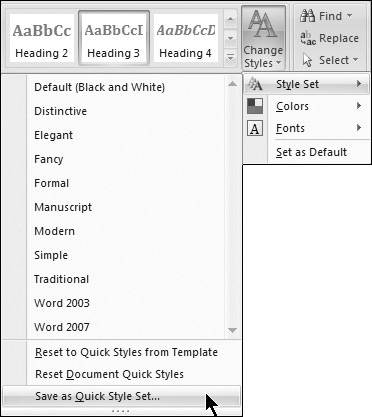
In the Save Quick Style Set dialog, specify the name of the built-in set you want to modify or override. Suppose, for example, that you want a custom version of the Elegant Quick Style Set. In File Name, type Elegant (you don’t need to type the .dotx extension). Note that this will not actually modify or overwrite the original file. Then click Save. Or, to create your own Quick Style Set, type a new name (such as My Elegant) and choose Save.
If creating your own style set named Elegant doesn’t overwrite Word’s version, then how does Word know to use yours instead of its own? As indicated earlier in this chapter, Word keeps its own Quick Style sets in one of the Microsoft Office Program Files folders. It saves your Quick Style sets, however, to the C:Documents and Settingsuser nameApplication DataMicrosoftQuickStyles folder (in XP) or C:Usersuser nameAppDataRoamingMicrosoftQuickStyles (in Vista). When you display the Quick Style sets list by choosing Change Styles ![]() Style Set on the Home tab, Word builds the list from a combination of the user folder and its “own” folder, giving priority to any user Quick Style set names that are the same as the Quick Style set names that ship with Word.
Style Set on the Home tab, Word builds the list from a combination of the user folder and its “own” folder, giving priority to any user Quick Style set names that are the same as the Quick Style set names that ship with Word.
To revert to a Quick Style set that comes with Word, simply delete or rename your own. In general, however, you increase your options by not giving your Quick Style sets the same names as those that come with Word.
Tip
Do you have customized styles in your
Normal.dotm
file? If so, before working with Quick Style sets, protect your original
Normal.dotm
Quick Style set by saving it as a unique Quick Style set. To do this, press Ctrl+N to create a new document window based on
Normal.dotm. On the Home tab of the Ribbon, choose Change Styles ![]() Style Set
Style Set ![]() Save as Quick Style Set. In File Name, choose a name that’s unambiguously clear, such as
My Favorite QuickStyles.
Save as Quick Style Set. In File Name, choose a name that’s unambiguously clear, such as
My Favorite QuickStyles.
Changing your mind
If you’ve been experimenting with Quick Style sets but now want to revert either to the document’s own styles or to those of the underlying template, you probably can. To be able to revert to the document’s own original styles, the document must not have been saved and closed. Even when the document has been saved, you can revert to the document’s original styles as of when the document was opened.
To revert to the document styles that were in effect at the beginning of the current editing session, choose Home ![]() Change Styles
Change Styles ![]() Style Set. As shown in Figure 7-10, click Reset Document Quick Styles.
Style Set. As shown in Figure 7-10, click Reset Document Quick Styles.
Figure 7-10. As long as the current document hasn’t been saved and closed since the last Quick Style set change, you can revert to the document’s original set of Quick Styles.
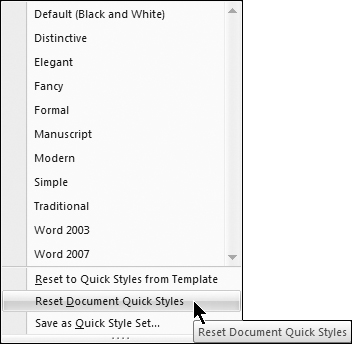
To be able to revert to the styles of the underlying template, you must not have saved Quick Style set changes to the template. Otherwise, reverting won’t do anything other than reapply styles that are already in effect. Unlike the document itself, where a mere save doesn’t prevent you from being able to go back to square one, a mere save to the underlying template does commit the style changes in that case. If you did that, see the tip at the end of the preceding section.
Assuming that you haven’t saved a Quick Style set to your current document template, you can revert to its styles. Choose Change Styles ![]() Style Set
Style Set ![]() Reset to Quick Styles from Template on the Home tab (refer to Figure 7-10).
Reset to Quick Styles from Template on the Home tab (refer to Figure 7-10).


